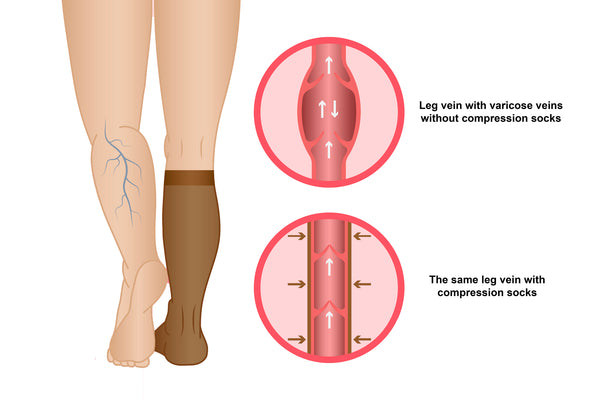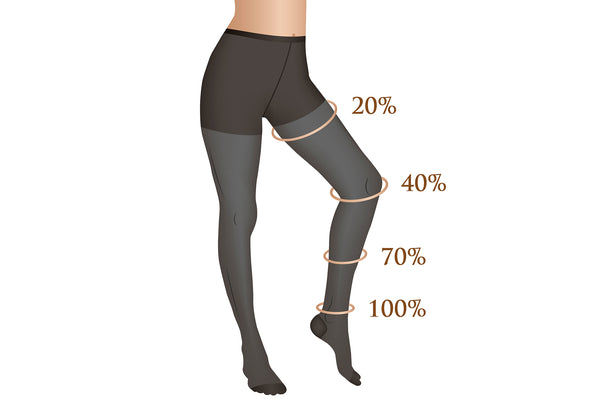Overview
Having less heavy legs feeling is possible thanks to compression stockings!
Unlike ordinary socks, they help relieve fatigue, heaviness, and swelling in the legs.
In 15 20 mmHg, Men or Women can wear them to improve blood flow or perform better in sports such as running. They also help to prevent venous disease.
In 30 40 mmHg or 20 30 mmHg, compression socks help treat venous insufficiency-related problems, such as:
- Varicose veins
- Phlebitis
- Blood clots
- Or DVT (deep vein thrombosis)
These support stockings come in many colors and styles to suit all tastes and occasions.
This beginner's guide explains the following:
What do compression socks do?
Also called compression hosiery or support socks, compression stockings vary in compression grades, lengths, or styles.
Women or men use them in various situations, depending on their type or style.

Besides their health benefits, they also help improve users' quality of life and the aesthetics of swollen legs.
The benefit of compression socks:
Men's or women's compression socks stimulate dysfunctional veins and allow better blood flow to the heart.
The compression materials exert a graduated pressure on the leg to help achieve enhanced blood circulation.

This compression is more robust at the ankle level and gradually decreases as the socks reach the knees or thighs.
For more details, see our blog about the eight benefits of compression socks.
What's venous insufficiency?
Venous insufficiency problems, such as varicose veins, are caused by poor venous return between the lower body parts (ankle, calf, or thigh) and the heart.
This bad blood circulation is due to a malfunction of certain vein valves in the leg. These pump blood poorly to the heart.

In some cases, chronic venous insufficiency may increase the risk of developing severe venous diseases, such as phlebitis, deep vein thrombosis, or even pulmonary embolism.
Deep vein thrombosis, or DVT, results in blood stagnation in the lower limbs, causing symptoms such as pain or tingling in the leg or thigh.
Wearing medical compression stockings improves blood flow. They also help to ease various symptoms related to venous diseases, such as:
- Swelling in legs
- Swollen ankles
- Heavy legs
- Cramps
- Skin Ulcer
- Blood clots
- Varicose veins, etc.
Side effects of wearing compression stockings
Wearing medical-grade compression socks for swelling or varicose veins incorrectly or choosing the wrong size or compression grade can lead to side effects.
Using compression stockings that are unsuitable for your venous disease or poor quality can also aggravate your venous insufficiency.
Among the problems caused by the misuse of support stockings:
- Itchy legs
- Leg pain
- More severe edema in the legs
- More difficult blood circulation
For more details, see our blog about the side effects of wearing compression stockings.
When to wear compression socks?
Men or women can wear compression stockings not only to treat varicose veins or a swollen leg but also at work, for running, or for long flights:
Compression socks for traveling
Wearing compression socks on long flights may help prevent swelling in the legs.
People at risk of developing deep vein thrombosis, embolism, or blood clots can also wear medical grade travel compression stockings. But, to avoid side effects, a doctor must prescribe these.
Compression socks for running
Putting on compression stockings for running provides many benefits. First, they can help you recover better.
In some cases, they can improve performance when playing a sport, thanks to better blood circulation and better body oxygenation.
Compression socks for swelling
One of the most common symptoms of venous insufficiency is edema in the legs.
Wearing compression socks for swelling at work or elsewhere helps deflate swollen ankle or calf.
Indeed, the graduated compression of these stockings avoids the accumulation of fluids in the body's lower limbs.
Compression socks for varicose veins
Regularly using men's or women's compression stockings for mild to moderate varicose veins can reduce symptoms and prevent them from progressing faster.
Medical professionals sometimes recommend varicose veins compression stockings, even after sclerotherapy or other treatments. They can help prevent the formation of new varicose veins in the legs.
Compression socks in pregnancy
Pregnancy increases the risk of developing symptoms of venous insufficiency and varicose veins.
Putting on women's compression socks for pregnancy can help relieve aching legs and deflate swollen ankles and feet.
Compression stockings grades
The grade of compression stockings indicates the strength of graduated pressure that the compression fabric applies to your legs, starting at the ankle and up to the calf or thigh.
Choosing one compression grade over another depends on the type and severity of the patient venous insufficiency.
What is mmHg in compression socks?
Compression socks levels or grades are measured in mmHg or millimeters of mercury, a unit commonly used to measure blood pressure.
What level of compression socks do I need?
The four most commonly used compression stockings grading are:
- 15 20 mmHg: 15 20 compression socks are mainly used to prevent venous insufficiency. They also help improve sports recovery, relieve fatigue and heaviness in the legs, or be worn for travel on long flights
- 20 30 mmHg compression stockings: this is the first grade of medical-grade compression. Doctors prescribe 20 30 mmHg compression socks to treat swollen ankle, heavy leg, or mild to moderate varicose vein
- 30 40 mmHg compression socks: are the second grade of medical compression. Men or women wear them to help treat more severe venous diseases like varicose veins, phlebitis, or DVT (deep venous thrombosis).
- 40 50 mmHg: this compression level is used in more chronic cases
Non-graduated versus graduated compression stockings
We talk about graduated compression stockings when the compressive fabric pressure decreases progressively.
In other words, this means that the medical compression applied to the leg is more important at the ankles and decreases going up the leg.

Generally speaking, graduated compression stockings are considered to be better quality than non-graduated stockings.
Compression stockings styles:
Compression stockings are available in many styles:
- Compression socks for ankles: these no-show socks are used for running or other sport
- Knee high compression socks: this style is used for venous insufficiency or varicose veins at calf and ankle levels
- Thigh high compression socks: these over the knee compression socks are worn to relieve varicose veins that affect the entire leg
- Compression pantyhose: they serve the same purpose as thigh high compression socks
- Maternity compression socks: they are specially designed for venous insufficiency during pregnancy
- Closed toe or toeless compression socks
To get familiar, see our blog about compression socks lengths and their use.
Non-measured, measured, or custom made compression socks
Compression socks can be non-measured, pre-measured, or custom-made.
Measured and custom compression socks are fitted more accurately. Besides, accurate sizing provides more beneficial compression therapy.
Which type to use?
Medical compression stockings for women
Women's compression hose is designed to adapt to the morphology, specific needs, style, and look sought after by active women.
Medical grade compression socks for men
Compression socks for men are available in opaque or transparent designs.
In both cases, they are made to fit the style and measurements of men.
Travel compression socks
Some compression socks for travel are worn to prevent swollen legs.
Others, with more advanced compression levels, are worn on planes by people who already suffer from venous disease.
Compression socks for maternity
These compression stockings for women are worn during and after pregnancy.
Pregnant women can wear standard thigh-high stockings. They can also opt for maternity compression pantyhose. The latter is specially designed to fit the belly during pregnancy.
Runner compression socks
Compression socks for running have the appearance of a regular sports stocking. Materials may differ from model to model.
Runner compression socks are made of cotton, merino wool, or a fiber blend.
Nursing compression socks
Nurses wear compression stockings at work to improve their blood circulation. Working standing up puts them at an increased risk of developing venous insufficiency.
Nursing compression socks can be knee high or thigh high.
The compression grade can vary between 15 20 mmHg, 20 30 mmHg, or 30 40 mmHg, depending on the need.
See our blog about compression socks for nurses to learn how to use them, their benefits, and how to choose them.
Compression socks for plus size
Compression socks for plus size are made with wide calf and thigh.
Some models, such as the Circutrend collection by Doctor Brace, are offered in XL, 2XL, 3XL, or even 4Xl.
Plus size compression socks provide many benefits for obese people. The most obvious one is the prevention and treatment of chronic venous diseases.
Tips - answers to some frequent questions
How to wear compression socks?
Wearing compression socks well helps you get the most out of them.
You should wear them as soon as possible in the morning before you even start your day.
There are several ways to wear them and remove them properly. To learn more, check out our blog about how to put on compression socks. You can also watch our tutorial on the same subject:
We recommend donning gloves or compression socks donner to avoid damage to your stockings.
Care instructions
Maintaining compression stockings requires special attention. We recommend washing them by hand after each use using lukewarm water and a compression socks detergent or mild natural soap.
Be careful; do not twist them. Drying must be done flat, in the open air.
See our blog to know how to wash your compression socks correctly. Also, you can watch the tutorial prepared by Doctor Brace:
Therefore, wearing compression socks must be done daily; buying at least one spare pair is recommended.
Note: Before maintaining and washing your compression hosiery, we recommend reading the manufacturer's care instructions.
How long to wear compression socks?
People who have already suffered from chronic venous insufficiency in their lives should wear compression socks at all times, even if the symptoms are less noticeable or visible.
It is essential to put them on every day to maximize their benefits when you get out of bed.
Do compression socks work?
Yes, compression socks can help reduce venous insufficiency if the user follows all indications for use accordingly.
Also, it is vital to choose the right size for you and follow your doctor's advice.
How long do compression stockings last?
The typical useful life of medical compression socks is about six months.
We are talking about the therapeutic effect of compression stockings rather than how they look. But, of course, the latter depends on how you maintain your socks.
In conclusion
We prepared this guide to help you learn more about compression stockings. More specifically:
- What they are
- Their uses
- Types
- Compression levels
- Styles, etc.
Compression socks are a good solution for those with heavy, swollen, achy legs or venous diseases.
Today's stockings provide everyday comfort and lightness while keeping your legs in good shape.
Article last updated: April 10, 2024.





